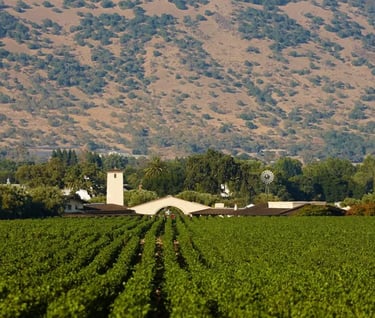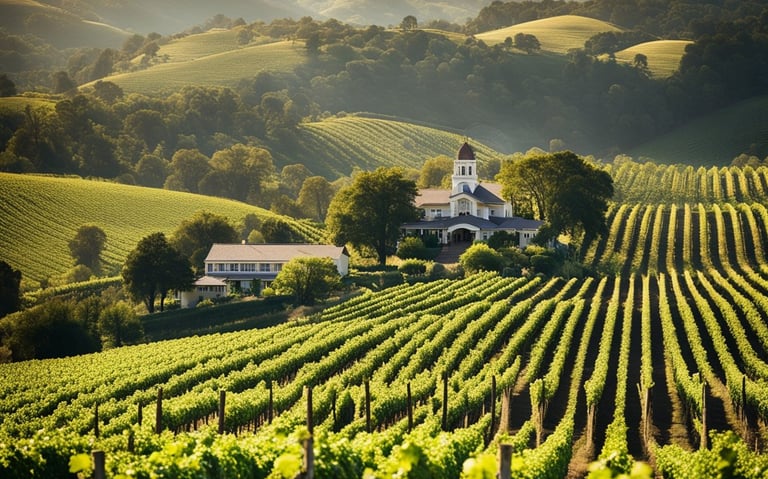
Subscribe to our newsletter
Napa Valley-Decoding Napa's Terroir
Part 2
BONUS-TRACK
2/15/2024
The Singular Nature of Napa's Climate and Terroir
Napa Valley, a jewel nestled within the larger California wine country, is globally recognized for its viticultural vivacity, a direct outcome of its distinctive climate and multifaceted terroir. The valley's terroir is an artist, with the climate as its paint and the land as its canvas, creating masterpieces sought after by collectors and investors alike.
Maritime Influence and Diurnal Shifts
Napa's climate is characterized by its proximity to the Pacific Ocean and San Pablo Bay, which ushers in cooling maritime breezes and morning fog – a respite for the vines from the searing Californian sun. This maritime influence, coupled with marked diurnal temperature shifts, preserves the critical acidity in the grapes, imbuing the wine with a balanced, structured profile that is both complex and age-worthy.
Microclimates and Their Expressions
The Valley's patchwork of microclimates is a testament to its diverse terrain. From the cool, wind-swept Carneros, favoring the cultivation of Pinot Noir and Chardonnay, to the warmer St. Helena, where the heat-loving Cabernet Sauvignon thrives, each microclimate contributes to a wine's unique expression. The wines from Atlas Peak, with higher elevation and volcanic soils, present robust tannins and intensity, while those from the valley floor in Rutherford offer the famed 'Rutherford dust' profile, a term that has become synonymous with the rich, earthy qualities found in the wines there.


Soil Diversity: A Geological Mosaic
Napa's soils are a geological mosaic, with over half of the world's soil orders represented, ranging from volcanic to alluvial, each imparting distinct characteristics to the grapes. In areas like the Howell Mountain AVA, volcanic soils stress the vines, resulting in smaller berries with concentrated flavors. Contrast this with the alluvial fan soils of Oakville, which provide excellent drainage and contribute to the opulent, velvety textures of the wines.
The Role of Topography
The undulating topography of Napa, with its hills and valleys, creates a complex interplay of sunlight and shadow, which, in turn, affects grape maturation. The slopes of Mount Veeder, for example, receive less intense sunlight, slowing ripening and allowing for the development of nuanced flavors and tannins.
Investment Implications
For investors, understanding Napa's climate and terroir is paramount. It's the interplay of these factors that underpins the Valley's reputation for producing some of the world's most prestigious and investable wines. A vintage that encapsulates the best of Napa's climate and terroir can not only bring immense drinking pleasure but also significant appreciation in value over time.
Napa's terroir is not static; it's a living, breathing entity that continues to evolve. Climate change presents new challenges and opportunities, and Napa's vintners are adapting with innovative techniques to ensure that the wines continue to reflect the exceptional qualities for which they are renowned. This responsiveness to the environment is yet another layer in the valley's investment story, showcasing a commitment to sustainability and quality that resonates with modern investors.
Geographical Diversity within the Valley
Investing across the various AVAs (American Viticultural Areas) within Napa adds another layer of diversity. From the cool-climate elegance of wines from the Los Carneros AVA to the intense, sun-bathed bottles from Calistoga, geographical diversity brings not only a complexity of taste but also of investment profiles. Some AVAs may gain prominence as consumer preferences evolve, and having a presence across the spectrum ensures a robust and resilient collection.
Concluding Thoughts on Collection Strategies
In sum, a well-crafted Napa Valley wine portfolio mirrors the complexity of the region itself. It is a blend of past, present, and future, of certainty and speculation. It is as much an investment in the sensory delight of wine as it is in the financial returns it can yield. By marrying the established with the emergent, the classic with the contemporary, the collector not only safeguards their investment but also enriches their experience of Napa's vinous tapestry.
Napa Valley's fusion of tradition, innovation, and prestige makes it an exceptional choice for wine investment. Its wines not only promise enjoyment but also hold the potential for significant appreciation. As an expert in the field, I encourage enthusiasts and investors to explore Napa's offerings, understanding the depth and breadth of opportunities it presents.
For more insights into fine wine investments and to stay updated on the latest trends and opportunities, subscribe to the WineLux newsletter. With over 60 articles published in 2023, our content is designed to enrich your understanding and enhance your investment journey in the world of fine wines.




Crafting a Strategic Napa Wine Portfolio
When venturing into the illustrious world of Napa Valley wines, the connoisseur and investor must consider a multifaceted strategy. It is not merely about collecting; it's about curating a portfolio that reflects both the heritage and the pioneering spirit of Napa.
Balancing Icons with Innovators
An astute collection includes wines from venerable estates known for their steadfast quality over decades, such as Robert Mondavi or Stag's Leap Wine Cellars, whose narratives are interwoven with the very history of Napa itself. Alongside these icons, the savvy investor will look to the horizon, identifying avant-garde winemakers who are redefining the boundaries of Napa's wine scene. These might include boutique wineries with a focus on sustainable viticulture or those experimenting with less common varietals in the valley, offering a new palate of flavors and investment potential.
Vintage Variation: A Dance with Nature
Diversification extends to vintages. Napa's vintage variation can bring about profound differences in the wine's profile, with some years offering exceptional aging potential. A diverse portfolio captures the essence of these variations. For example, the opulent and ripe 2012 vintage presents a different cellaring prospect compared to the more structured and possibly longer-lived 2013s. This temporal spread allows investors to plan for a staggered maturation timeline, providing a continuous stream of peak drinking experiences and sales opportunities.
Varied Varietals: A Spectrum of Possibilities
Though Napa is synonymous with Cabernet Sauvignon, its terroir is also conducive to a breadth of other varietals. Merlot, Cabernet Franc, and even white wines like the vibrant Sauvignon Blancs and opulent Chardonnays have their place. Each varietal contributes its voice to the chorus of Napa's portfolio, offering a hedge against the ebbs and flows of market trends and varietal popularity.
